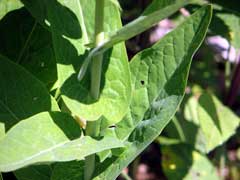 |
|
http://commons.wikimedia.org/wiki/User:$Mathe94$ |
 |
| http://commons.wikimedia.org/wiki/User:$Mathe94$ |
Translate this page:
Summary
Physical Characteristics

 Peltaria alliacea is an evergreen Perennial growing to 0.3 m (1ft) by 0.3 m (1ft in).
Peltaria alliacea is an evergreen Perennial growing to 0.3 m (1ft) by 0.3 m (1ft in).
See above for USDA hardiness. It is hardy to UK zone 6 and is not frost tender. It is in leaf all year, in flower in June, and the seeds ripen in August. The species is hermaphrodite (has both male and female organs).
Suitable for: light (sandy) and medium (loamy) soils. Suitable pH: mildly acid, neutral and basic (mildly alkaline) soils. It can grow in semi-shade (light woodland) or no shade. It prefers moist soil.
UK Hardiness Map
US Hardiness Map
Synonyms
Plant Habitats
Woodland Garden Sunny Edge; Dappled Shade; Shady Edge; Ground Cover;
Edible Uses
Edible Parts: Flowers Leaves
Edible Uses:
Leaves - raw or cooked[105]. A strong flavour, somewhat like a cross between garlic and mustard, the leaves make a reasonable flavouring for salads[K]. The leaves are available for most of the year, even in a severe winter they remain green and lush[K]. At this time they add an especially welcome spiciness to salads[K]. They can become rather bitter in the summer, though, especially if the plants are in a dry sunny position[K]. When flowering in early summer, the plants lose their leaves for a month or two - cutting down the flowering stems at this time will induce new fresh green growth[K]. Flowers - raw. A similar flavour to the leaves, with very little bitterness, they make a very tasty addition to summer salads[K].
References More on Edible Uses
Medicinal Uses
Plants For A Future can not take any responsibility for any adverse effects from the use of plants. Always seek advice from a professional before using a plant medicinally.
None known
References More on Medicinal Uses
The Bookshop: Edible Plant Books
Our Latest books on Perennial Plants For Food Forests and Permaculture Gardens in paperback or digital formats.

Edible Tropical Plants
Food Forest Plants for Hotter Conditions: 250+ Plants For Tropical Food Forests & Permaculture Gardens.
More

Edible Temperate Plants
Plants for Your Food Forest: 500 Plants for Temperate Food Forests & Permaculture Gardens.
More

More Books
PFAF have eight books available in paperback and digital formats. Browse the shop for more information.
Shop Now
Other Uses
References More on Other Uses
Cultivation details
Prefers a light fertile moist soil in sun or light shade[200], though it is not too fussy[K]. A very easily grown plant that tolerates considerable neglect, it produces its best crop of leaves from autumn to spring and is a potentially valuable winter salad plant[K]. The bruised leaves give off a powerful garlic smell which is difficult to remove from the hands[245].
References Carbon Farming Information and Carbon Sequestration Information
Temperature Converter
Type a value in the Celsius field to convert the value to Fahrenheit:
Fahrenheit:
The PFAF Bookshop
Plants For A Future have a number of books available in paperback and digital form. Book titles include Edible Plants, Edible Perennials, Edible Trees,Edible Shrubs, Woodland Gardening, and Temperate Food Forest Plants. Our new book is Food Forest Plants For Hotter Conditions (Tropical and Sub-Tropical).
Shop Now
Plant Propagation
Seed - sow spring or autumn in a cold frame[200]. The seed germinates rapidly, prick the seedlings out into individual pots when they are large enough to handle and plant them out into their permanent positions in the summer[K]. Division in spring or autumn. Very easy, it can be done at almost any time of the year so long as the soil is kept moist. Divisions in the winter should be potted up in a greenhouse to allow themselves to establish, they can then be planted out in late spring.
Other Names
If available other names are mentioned here
Native Range
Coming Soon
Weed Potential
Right plant wrong place. We are currently updating this section.
Please note that a plant may be invasive in one area but may not in your area so it's worth checking.
Conservation Status
IUCN Red List of Threatened Plants Status :

Growth: S = slow M = medium F = fast. Soil: L = light (sandy) M = medium H = heavy (clay). pH: A = acid N = neutral B = basic (alkaline). Shade: F = full shade S = semi-shade N = no shade. Moisture: D = dry M = Moist We = wet Wa = water.
Now available:
Food Forest Plants for Mediterranean Conditions
350+ Perennial Plants For Mediterranean and Drier Food Forests and Permaculture Gardens.
[Paperback and eBook]
This is the third in Plants For A Future's series of plant guides for food forests tailored to
specific climate zones. Following volumes on temperate and tropical ecosystems, this book focuses
on species suited to Mediterranean conditions—regions with hot, dry summers and cool, wet winters,
often facing the added challenge of climate change.
Read More
Expert comment
Author
Jacq.
Botanical References
50200
Links / References
For a list of references used on this page please go here
Readers comment
© 2010, Plants For A Future. Plants For A Future is a charitable company limited by guarantee, registered in England and Wales. Charity No. 1057719, Company No. 3204567.